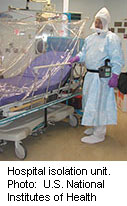- Skip Storing This Everyday Product in the Fridge Door
- Green Tea + B3 Pairing May Boost Brain Health
- Navigating Your Midlife Crisis: Embracing New Possibilities
- City Raccoons Showing Signs of Domestication
- Mapping the Exposome: Science Broadens Focus to Environmental Disease Triggers
- One Week Less on Social Media Linked to Better Mental Health
- Your Brain Changes in Stages as You Age, Study Finds
- Some Suicide Victims Show No Typical Warning Signs, Study Finds
- ByHeart Formula Faces Lawsuits After Babies Sickened With Botulism
- Switch to Vegan Diet Could Cut Your Greenhouse Gas Emissions in Half
Full Recovery Possible for 2 U.S. Ebola Patients


The two American aid workers being treated for Ebola virus face a long, hard road to full recovery, but shouldn’t endure long-term illness or disability because of their brush with the deadly pathogen, says one of the United States’ most experienced Ebola experts.
Dr. Kent Brantly and Nancy Writebol likely will spend weeks, if not months, regaining their strength and body weight following the ravages of Ebola, said Dr. Joseph McCormick, regional dean of the University of Texas School of Public Health in Brownsville.
But they most likely haven’t endured any permanent organ damage or contracted a lasting chronic illness from the virus, McCormick said, and ought to emerge from their struggle with immune resistance against future Ebola infection.
He said most survivors “get pretty much back to normal” over time, but admitted “this is something we know less about than we should.”
McCormick is one of the very few U.S. physicians with first-hand experience with Ebola. As an officer with the U.S. Centers for Disease Control and Prevention, he belonged to the team that investigated the first Ebola epidemic in 1976, which occurred in the Congo, as well as the next two African outbreaks of Ebola.
The families of Brantly, 33, and Writebol, 59, have reported that the two show signs of improvement every day, even though they remain under quarantine at Emory University Hospital in Atlanta. Both contracted the hemorrhagic illness in Liberia.
Ebola victims who survive — the virus kills 60 to 90 percent of those it infects — first must deal with the loss of body mass caused by their illness, McCormick said.
“Over a period of two to three weeks, in addition to becoming physically very weak, they lose a lot of body mass,” he said. “It’s difficult for them to move around at all, and it takes some time for them to regain the ability to eat much.”
Brantly and Writebol are likely to suffer from fatigue and weakness for a month to six weeks, depending on their age and their overall health, he said.
They also will likely feel some echoes of the overwhelming pain that Ebola infection causes, McCormick said.
Patients with Ebola experience terrible headaches plus body and muscle pain. “They have a tremendous sore throat, to the point where they cannot swallow their own saliva,” he said.
At this point, there’s not a lot that doctors can do for the two aid workers, besides monitoring their vital statistics, providing pain medications, and encouraging them to eat and drink, McCormick said.
Physicians also will closely track their progress in hopes it will further understanding of the course of an Ebola infection, said Dr. Jeffrey Duchin, chair of the Infectious Diseases Society of America’s Public Health Committee.
“We don’t have the opportunity to study Ebola patients closely very often,” said Duchin. “These two patients provide an opportunity to learn a little more about the course of Ebola, but that’s complicated by the fact that they’ve received this experimental treatment with the ZMapp antibody cocktail.” Because of that treatment, the degree to which you can draw conclusions about other patients with Ebola virus infection is likely to be limited, he said.
Public health officials have not yet said when quarantine will be lifted for the two, although it will likely be about 21 days after each person’s last contact with a person infected with Ebola, based on the virus’ maximum incubation period.
It is very likely that both have cleared the virus and are noninfectious at this point, Duchin and McCormick said.
“If you walked up to them today and shook their hand, you would not get infected,” McCormick said.
But Ebola has shown an ability to hide in reservoirs in the body, McCormick and Duchin said, and it has been found in the urine and semen of people weeks out from recovery.
“It seems to be able to hide in some places . . . but eventually the virus does go away,” McCormick said. “It can take a month or two.”
Duchin noted one instance in which Ebola was found in a man’s semen 61 days after infection. The man, a lab worker who contracted Ebola when stuck with a needle, recovered from illness far more severe than that which Brantly and Writebol appear to have suffered, he said.
When both aid workers do make a full recovery, they likely will have one much-envied health advantage over most people, McCormick said — a naturally acquired immunity to Ebola.
“They absolutely build up immune resistance,” he said. “If I were out there right now running the program in West Africa, I would be looking for people who are far enough out of recovery that they feel well again. Those are the people I would be training to take care of patients, because they are the least likely to become reinfected.”
The epidemic continues to rage in the West African countries of Guinea, Liberia, Nigeria and Sierra Leone. A total of 1,069 deaths have been reported, according to the World Health Organization, out of 1,975 reported Ebola infections.
More information
For more on Ebola virus, visit the U.S. Centers for Disease Control and Prevention.
Source: HealthDay
Copyright © 2025 HealthDay. All rights reserved.










